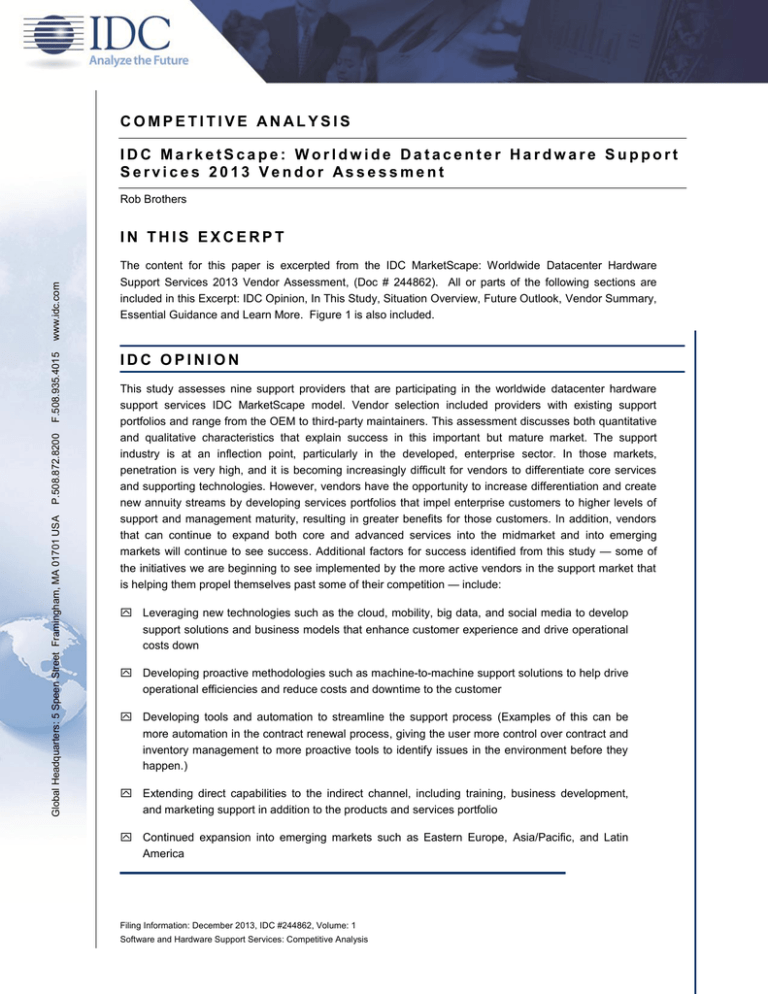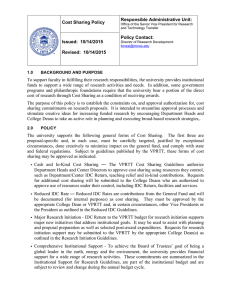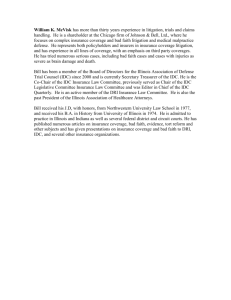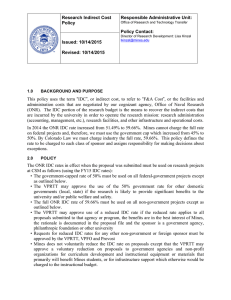
COMPETITIVE ANALYSIS
IDC MarketScape: Worldwide Datacenter Hardware Support
Services 2013 Vendor Assessment
Rob Brothers
Global Headquarters: 5 Speen Street Framingham, MA 01701 USA
P.508.872.8200
F.508.935.4015
www.idc.com
IN THIS EXCERPT
The content for this paper is excerpted from the IDC MarketScape: Worldwide Datacenter Hardware
Support Services 2013 Vendor Assessment, (Doc # 244862). All or parts of the following sections are
included in this Excerpt: IDC Opinion, In This Study, Situation Overview, Future Outlook, Vendor Summary,
Essential Guidance and Learn More. Figure 1 is also included.
IDC OPINION
This study assesses nine support providers that are participating in the worldwide datacenter hardware
support services IDC MarketScape model. Vendor selection included providers with existing support
portfolios and range from the OEM to third-party maintainers. This assessment discusses both quantitative
and qualitative characteristics that explain success in this important but mature market. The support
industry is at an inflection point, particularly in the developed, enterprise sector. In those markets,
penetration is very high, and it is becoming increasingly difficult for vendors to differentiate core services
and supporting technologies. However, vendors have the opportunity to increase differentiation and create
new annuity streams by developing services portfolios that impel enterprise customers to higher levels of
support and management maturity, resulting in greater benefits for those customers. In addition, vendors
that can continue to expand both core and advanced services into the midmarket and into emerging
markets will continue to see success. Additional factors for success identified from this study — some of
the initiatives we are beginning to see implemented by the more active vendors in the support market that
is helping them propel themselves past some of their competition — include:
Leveraging new technologies such as the cloud, mobility, big data, and social media to develop
support solutions and business models that enhance customer experience and drive operational
costs down
Developing proactive methodologies such as machine-to-machine support solutions to help drive
operational efficiencies and reduce costs and downtime to the customer
Developing tools and automation to streamline the support process (Examples of this can be
more automation in the contract renewal process, giving the user more control over contract and
inventory management to more proactive tools to identify issues in the environment before they
happen.)
Extending direct capabilities to the indirect channel, including training, business development,
and marketing support in addition to the products and services portfolio
Continued expansion into emerging markets such as Eastern Europe, Asia/Pacific, and Latin
America
Filing Information: December 2013, IDC #244862, Volume: 1
Software and Hardware Support Services: Competitive Analysis
IN THIS STUDY
This study is IDC's datacenter hardware support services provider assessment of the
worldwide support services market using the IDC MarketScape model. This assessment
discusses both quantitative and qualitative characteristics that explain success in this
important but slow-growing market. This study is composed of two sections. The first
section describes characteristics that IDC believes lead to success in the support
services market. These characteristics are based on vendor surveys conducted for this
study, IDC's end-user research, and analyst observations of best practices.
The second part of this study is a visual presentation of the resulting vendor analysis in
a single bubble chart. This display concisely exhibits the quantified scores of the
reviewed vendors along two axes — strategies and current capabilities — which
determine if the vendor is a Leader, a Major Player, a Contender, or a Participant. In
addition, vendor market size (as determined by direct support revenue) is indicated by
the size of the bubble. This section also provides vendor summaries that discuss IDC's
positioning of each vendor in the market along with commentary on strengths reflected
in their scoring, as well as opportunities for improvement. The document concludes with
IDC's essential guidance to vendors in support of growth and improved offerings.
Please note that this IDC MarketScape study includes datacenter hardware support
services only.
Methodology
IDC MarketScape criteria selection, weightings, and vendor scores represent wellresearched IDC judgment about the market and specific vendors. IDC analysts tailor
the range of standard characteristics by which vendors are measured through
structured discussions, surveys, and interviews with market leaders, participants, and
end users. Market weightings are based on user interviews, buyer surveys, and the
input of a review board of IDC experts in each market.
IDC analysts base individual vendor scores, and ultimately vendor positions, on the
IDC MarketScape graphic, on a detailed evaluation of each vendor, publicly available
information, end-user experiences, and the input of a review board composed of IDC
experts in the market in an effort to provide an accurate and consistent assessment of
each vendor's characteristics, behavior, and capability. The evaluation process
involves several steps, including the following:
A questionnaire is completed by each vendor to characterize the scope of each
vendor's core technology portfolio, as well as to highlight solutions that the
vendor considered to be primary differentiators.
Business briefings are conducted with each vendor to learn about each group's
growth, sales, marketing, customer service, and offering strategies as well as
background information about business performance, offering differentiators, and
key market trends. The briefings are initiated with a request to deliver the briefing
based on a standard set of questions. The briefings are used to score the
strategy sections of the IDC MarketScape.
©2013 IDC
#244862
1
Reference interviews with approximately five customers from each participating
vendor gauge the customers' experience working with the vendor and the overall
complexity of the project. Customer reference interviews are built around a
standard set of questions. Customer reference interviews are used to score
different elements of the capabilities section of the IDC MarketScape.
Hardware Support Services Market Definition
IDC has defined two specific areas of hardware support services:
Datacenter support services covers all assets that reside within the four walls of
a datacenter; these items include servers, storage, and networking. Datacenter
support tends to be more stringent as far as service-level agreements (SLAs) go
and face more scrutiny when those SLAs are not met.
Deskside or client device support services assets include items like printers,
monitors, PCs, laptops, tablets, and smart devices. Note that these devices
generally don't carry the same type of SLAs or support needs that datacenter
assets require.
SITUATION OVERVIEW
The worldwide market for support and deployment services has all but stagnated in
the past year, with a market size of approximately $63.2 billion. Vendors will need to
take a fresh look at the support market and create offerings that are higher in value
and more creative to satisfy the needs of the enterprises complex infrastructures.
Enterprises have seen the value of what IDC defines as the 3rd Platform, which
consists of mobile, social, cloud, and big data solutions and applications. Vendors are
developing portfolio strategies to help manage and maintain the IT environments that
host these new solutions. In this iteration of enterprise IT, organizations are required
to support legacy systems, converged infrastructures, cloud-based applications, and
software-defined storage, networks, or datacenters in heterogeneous environments.
The datacenter manager has to compete with resources such as Rackspace and
Amazon Web Services to keep the corporate enterprise datacenter relevant. That
said, the increasingly critical role of vendor-supplied support services is highlighted in
addressing these emerging IT environments going forward. Among the array of
factors to consider when maintaining and managing the datacenter are:
Increasing uptime assurance and security to deliver a high-quality end-user
experience
Matching IT needs with proper support contracts and contract consolidation for
proper SLA coverage and cost savings
Utilizing proactive services through tools and automation for faster issue
resolution
Simplifying and enhancing the support experience with a single point of contact
for support issues and simplified service contracts
2
#244862
©2013 IDC
Dynamic online contract and inventory management systems to allow the end
user access to the location, condition, and SLA on all datacenter assets as well
as the ability to track and open tickets on those assets
Introduction: Today's Infrastructure Trends
In today's rapidly changing world of IT, enterprises are deploying extensive, complex
infrastructures that enable critical business processes and provide secure and easy
access for end users from a variety of desktop and mobile devices. These advanced
infrastructures allow access to real-time data that can greatly increase productivity,
allowing businesses to respond quickly to market dynamics to achieve strategic
advantage.
In this environment, the traditional challenges associated with IT maintenance and
management is changing dramatically. Yesterday's challenges included managing
virtual machine sprawl and dealing with isolated silos of resources and the
disproportionate investment of IT resources in maintenance versus innovation. Those
challenges are now being replaced with new ones, such as how to support converged
infrastructures, cloud-based applications, and software-defined environments. As
businesses move forward and modernize their IT infrastructure to take advantage of
big data, social, and mobile opportunities, IT vendors are also investing in these
areas to provide better technical support for their customers' emerging requirements.
Today's environments are dramatically more productive and cost-effective. However,
the need for easy access to management and performance information, rapid
problem identification and resolution, and proactive guidance on best practices from
technology experts has not diminished. Datacenter managers must continually
improve on their processes to prevent line-of-business owners from looking externally
for resources. Enterprise datacenters need to provide IT resources in a manner that is
easily consumable by their IT users. To that end, vendors must provide the platforms,
associated services, and highly trained engineers that customers rely on for new
converged, software-defined, virtualized, and legacy systems. Providing this level of
support ensures that the performance needs of end users that rely on these
datacenters are met. It is also not enough for vendors to support just their own
technology with software-defined infrastructures on the horizon; they must also be
able to provide support for the other hardware and software providers involved in the
delivery of an organization's workload.
Managing operations in these new environments will continue to present significant
challenges for resource-strapped IT departments. In addition, talent shortages in
areas such as big data, software-defined architectures, and cloud computing are
already apparent. IDC believes that as a result of all these factors, CIOs and IT
managers will increasingly look to external support providers for help in building,
managing, and maintaining the enterprise IT infrastructure of the future. In turn,
support providers will need to modify their offerings in line with these changes.
Customers are looking for multiple attributes, including more personalized support
that is responsive to their unique needs; proactive products, tools, and technology to
avoid the business risks of downtime; and an uncomplicated support experience.
©2013 IDC
#244862
3
FUTURE OUTLOOK
IDC's opinion is that selective "outsourcing" (looking for specific areas of the
datacenter to utilize a lead service provider) of IT will become a part of the enterprise
organization over the next three to five years. Some of today's businesses have
already taken this step to cosource their IT assets. This evolution can be considered
IT as a service (ITaaS) or infrastructure as a service (IaaS), offered in many forms
with few standards and principles governing the management of these new models.
The IT department of today is evolving from being the "protector of the information
world" to becoming a "broker" of IT services, offering mobility and own-device
freedom to employees, and fast and effective client experiences to customers.
The CIO therefore no longer has to discuss and debate with the business his/her
requirements for IT resources but rather the value and cost benefits of each brokered
IT service. Business expectations dictate the need for standardized, efficient
enterprise-class services, which, in turn, mandate the CIO to drive down both capex
and opex, lower business risks imposed by IT failures and capacity issues,
continuously increase the quality of user experiences, and be agile enough to align
with business direction and decisions.
The next-generation IT has made it much easier for CIOs to deliver against this
mandate because of its consumption-based approach (pay only for what you use,
only when you use it). This model drives down costs and improves efficiencies as
new services can be launched much sooner and at much lower costs, and quality is
guaranteed and governed by SLAs with outsourcing service providers. Look for
support providers to help deliver a more holistic SLA-based support experience based
around two factors: uptime guarantees and performance indicators. This support will
be based off workload and not on individual components in a datacenter. Companies
like Rackspace and Amazon are already accomplishing this, and these are the
providers datacenter managers need to emulate.
IDC MarketScape: Worldwide Datacenter
Hardware Support Services Market
Vendor Assessment
IDC's assessment for the datacenter hardware support services market represents
IDC's evaluation of which vendors are well positioned today, through current
capabilities, and which have strategies that will allow them to gain market share over
the next few years. Positioning on the y-axis reflects the vendor's current capabilities
and how well those capabilities are aligned to customer needs, as well as how well a
vendor is delivering and executing its chosen strategy in the market. Positioning on
the x-axis or strategies axis indicates how well the vendor's future strategy aligns with
what customers will require in the next three to five years. The strategies category
focuses on high-level strategic decisions and underlying assumptions about offerings,
customer segments, business, and go-to-market plans.
Figure 1 shows each vendor's position on the x-axis and y-axis. Additionally, a
vendor's market size (as determined by support services revenue) is indicated by the
4
#244862
©2013 IDC
size of the bubble. Positioning on the grid is broken down into various groupings that
reflect the combined view of a vendor with respect to both strategies (x-axis) and
capabilities (y-axis).
The groupings are defined as follows:
Leaders are companies that have led and continue to lead the market in both
breadth of offering and strategic intent. These companies have made
investments in hardware support service portfolios, go-to-market enablement,
and delivery capabilities that set them apart from other vendors.
Major Players are companies that have established and proven offerings in the
market and have demonstrable success in delivering and delighting customers.
These companies are "shadowing" the Leaders and exert competitive pressures
via new capabilities, channel initiatives, and other differentiable capabilities that
raise the bar for all vendors in the market.
Contenders are companies that have defined managed print and document
services capabilities but have delivery resources, technology infrastructures, and
go-to-market coverage that are still being developed.
Participants are companies that are in the process of developing a support
service program or have initiated limited releases.
Based upon the final scores (on the x-axis and the y-axis), we make the following
high-level observations about the various players (see the Vendor Profiles and
Assessment section for more detailed vendor analysis):
There are only a couple of vendors in the leadership position, and this is by a
narrow margin. Leaders in datacenter hardware support services in IDC
MarketScape assessments have scored the highest among all players in the
strategies and capabilities categories. They have robust portfolios and welldefined go-to-market strategies targeting growth globally, across company size,
and through both direct and indirect distribution channels.
The rest of the vendors are Major Players. As Major Players, they have
demonstrated in-depth knowledge of the market, the trends impacting the
market, and how to leverage those trends for sustained growth.
No vendors ranked as Contenders or below because of the maturity of the
market space.
©2013 IDC
#244862
5
FIGURE 1
IDC MarketScape: Worldwide Datacenter Hardware Support
Services Vendor Assessment
Source: IDC, 2013
Vendor Profiles and Assessment
This section covers the various vendors that were assessed in this IDC MarketScape
and provides insights into their strengths.
Cisco
Cisco is a Leader in this IDC MarketScape and is one of the few vendors that has
seen some growth over the past few quarters in its support services revenue. Most of
that is because of an increase in the sale of its x86 product line and the continued
uptake, and now renewal, of "Smart" packages. Cisco's strategy for basic and
advanced support services around its core portfolio of networking, x86 systems,
6
#244862
©2013 IDC
collaboration, and communications is very sound. The primary deliverable, called
Smart Services, provides customers with a variety of choices for their network and
compute environment, some of which are:
Global 24-hour access to Cisco Technical Assistance Center (TAC)
Access to online knowledge base, communities, and tools
Hardware replacement options, including two-hour, four-hour, and next business
day
Operating system software updates
Expansion of the Smart Service offers and operating-level services (Remote
Management Services [RMS], FTS, NOS) that provide proactive and preventive
services
Cisco Remote Management Services enables management of Cisco technologies to
maximize performance and provide continuous monitoring and management of the
datacenter assets. With RMS, customers can identify and resolve issues quickly and
accurately while retaining visibility and control of their datacenters. Customers
utilizing these tools will have access to Cisco's experts with experience in datacenter
and emerging technologies.
Two key benefits of Cisco's support are its deep and highly experienced engineering
base, through its own and its partners' technicians, and the extremely rich knowledge
base that can be accessed through its online community. In a conversation, Joe
Pinto, senior VP of Technical Support Services, emphasized the pervasive technical
capabilities of Cisco's own and its partners' engineers and how dedicated they are to
training and certification.
Every year, Cisco enhances its Smart Services offerings as its technological
capabilities expand, creating richer proactive alerts, more robust monitoring tools, and
deeper systems analytics. The ongoing search to detect and fix issues before they
occur drives Cisco to use tools that will benchmark customer environments against
one another to help determine the best practices for configuration and installation of
complex datacenters.
IDC feels Cisco should continue to market its abilities to support other offerings, in
particular its x86 blade (UCS) environment. Cisco is very well positioned to provide
comprehensive offerings to its customers and its partner community to support x86
virtualized environments. Cisco's experience with FlexPod and VCE provides an
excellent inroad to expand the firm's support for complex heterogeneous
environments. IDC recommends enhancing Cisco's tools (Prime) to accommodate
monitoring of other vendors' equipment and virtualization software. With Cisco's
partnering strategy, the ability to accomplish this should not be a far reach. Overall,
Cisco provided a good overview of its core support offerings (networks), but the
company lacked insight into UCS and future support strategies.
©2013 IDC
#244862
7
ESSENTIAL GUIDANCE
IDC recommends utilizing support providers that continue to invest in proactive and
preventative support automation and online tools; vendors that develop these will be
able to lower their operational cost, which in turn should be able to provide a better
level of service at a better price point to their customers. Clearly, the modern
datacenter has transformed to provide virtualized, automated, and efficient delivery of
IT as it aligns with the business needs of the organization. While the technology to
enable this transformation is rapidly evolving, there is no one hardware or software
product that will solve these complex support issues overnight.
There has never been more at stake for IT departments to succeed. Among the
myriad decisions that IT organizations must make along this transformation process,
the single decision to create a deep, long-standing partnership with a trusted
technology and services provider will prove to be the most critical. Those
organizations that ultimately succeed will realize that the bulk of the transformation
will take place in the initial investment, when a services partner can maximize the
consumption of new technologies by filling the integration gap. More importantly,
successful organizations will also recognize the need to provide an ongoing
partnership to help protect, preserve, and enhance the initial investment, which will
extend overall value and lead to the greatest level of success in supporting changing
business goals over time.
LE ARN MORE
Related Research
Worldwide Clientless Remote Support Software 2013–2017 Forecast (IDC
#244467, November 2013)
Enterprise Datacenters and Third-Party Maintainers (IDC #243610, October
2013)
Preventative Support: Keeping Costly Downtime Out of the Datacenter (IDC
#242497, August 2013)
Worldwide and U.S. Hardware Support and Deployment Services 2013–2017
Forecast: Support on the Slow Growth Path (IDC #241886, June 2013)
Synopsis
This IDC study is IDC's datacenter hardware support services provider assessment of
the worldwide support services market using the IDC MarketScape model. This
assessment discusses both quantitative and qualitative characteristics that explain
success in this important but slow-growing market.
"IDC sees the datacenter hardware support services market as a very mature space,
with little disparity between support providers", says Rob Brothers, program director
for Hardware Support and Deploy Services at IDC. "All support providers have very
8
#244862
©2013 IDC
good offerings and well-established practices; hence the separation between vendors
is very small."
Copyright Notice
This IDC research document was published as part of an IDC continuous intelligence
service, providing written research, analyst interactions, telebriefings, and
conferences. Visit www.idc.com to learn more about IDC subscription and consulting
services. To view a list of IDC offices worldwide, visit www.idc.com/offices. Please
contact the IDC Hotline at 800.343.4952, ext. 7988 (or +1.508.988.7988) or
sales@idc.com for information on applying the price of this document toward the
purchase of an IDC service or for information on additional copies or Web rights.
Copyright 2013 IDC. Reproduction is forbidden unless authorized. All rights reserved.
©2013 IDC
#244862
9





